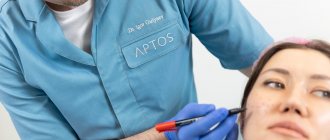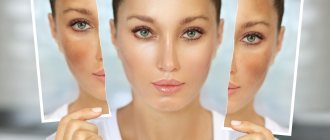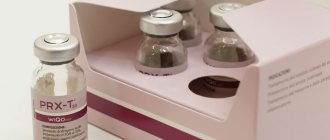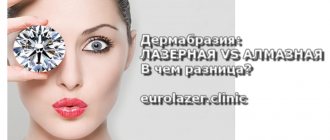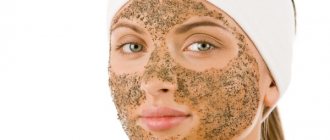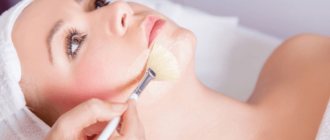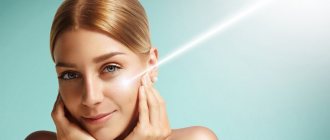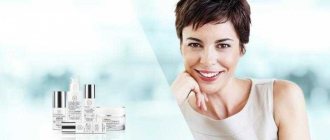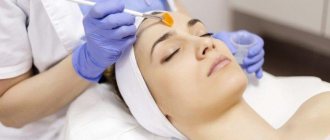- Indications
- Contraindications
- Kinds
- Distinctive features
- Principles of conducting
- Beneficial properties of hydroxyacetic acid
- Recovery period
- Side effects
- Course of procedures
- Glycolic peeling at home
- pros
- conclusions
To achieve aesthetic improvement of the skin, cosmetology uses procedures using diluted acids and biologically active substances - chemical peels, which differ in composition and method of action. One of the most gentle and effective methods is peeling with glycolic acid, which fully corrects imperfections and stimulates cellular metabolism.
What is a “glycol peel”?
Glycolic peeling is a common subtype of chemical peeling with superficial and medium effects, which has been used since the mid-20th century to exfoliate the upper layer of the epidermis, smooth out the relief and improve the quality of the skin. The procedure is based on the main element - concentrated glycolic (hydroxyacetic) acid, which belongs to the group of alpha hydroxy acids (fruit acids) and is naturally found in sugar cane, unripe beets and grapes. Glycolic acid is an active, safe component; it is transparent, hygroscopic, and odorless. The substance is used in complex products to eliminate skin defects and normalize tissue texture.
Rehabilitation period
The procedure can be carried out more than once. The interval between procedures is set by the cosmetologist, since it differs for each patient depending on the characteristics of the skin. According to average data, the procedure can be repeated no earlier than 7 days after peeling with glycolic acid. If a person has undergone a medium chemical peel, then a repeat procedure is allowed no earlier than after 3 months.
There is information that the skin will only need a few days to recover after the procedure. But this theory is not entirely true. After peeling with glycolic acid, the skin needs several weeks to adapt to fully recover. After all, he was exposed to an acidic mixture, albeit of a weak concentration.
After the procedure, a person needs to lubricate the skin with a cream that would protect it as much as possible (selection of the best post-peeling products). The skin needs three days of care with this product. If this instruction is not followed, pigment spots may appear on the skin due to exposure to ultraviolet rays. This is the only indication for the rehabilitation period.
When several days have passed after the procedure, the use of usual facial care cosmetics is allowed. Cosmetologists recommend paying attention to special products that help quickly restore the skin after such a procedure. A cosmetologist who performed facial peeling will help you find out about such cosmetic lines. In addition, most manufacturers that produce glycolic peeling also develop other products that help the skin recover after this type of procedure.
Indications for glycolic peeling
- Age-related skin changes: facial wrinkles, sagging, decreased elasticity in the face, neck, and décolleté.
- Photoaging: peeling, uneven relief, loss of elasticity.
- Oily, seborrheic skin: enlarged pores, acne, post-acne, comedones.
- Dryness, thinning of the skin.
- Hyperkeratosis is a thickening of the epidermis in the area of the stratum corneum.
- Hyperpigmentation.
- Superficial scars, stretch marks on the face and body.
- Prevention and treatment of molluscum contagiosum.
- Preparation for plastic surgery, mechanical and laser procedures.
Contraindications to glycolic peeling
- Pregnancy, lactation.
- Increased body temperature.
- Malignant, multiple benign neoplasms.
- Prolonged exposure to the sun and a fresh tan - less than two weeks.
- Increased photosensitivity of the skin.
- The active period of insolation is the summer and spring months.
- Viral and fungal diseases.
- Violations of the integrity of the skin: dermatitis, wounds, burns.
- Herpetic infection (for which glycolic peeling is very useful).
- Exacerbation of inflammatory processes and dermatoses.
- Autoimmune processes: scleroderma, systemic lupus erythematosus, rheumatoid arthritis.
- Severe damage to the cardiovascular system.
- Predisposition to keloid scars.
- Systemic and external use of retinoids and hormonal drugs.
- Individual intolerance to components.
Contraindications
There are a number of contraindications for performing glycolic exfoliation:
- rosacea;
- recent tanning;
- pronounced capillary network;
- wounds or inflamed pimples;
- active form of herpes;
- carrying a child or breastfeeding;
- moles and warts;
- heart or vascular disease;
- dermatitis;
- asthma;
- oncological diseases;
- diabetes.
Expert opinion
Elena Apostolyuk
Cosmetologist
Self-peeling should not be done for dry or combination types of epidermis, since the incorrect concentration of the active substance can lead to a deterioration of the initial condition of the skin.
Types of peeling by depth
- Superficial (acid concentration up to 40%, pH 2.5-4.5) - exfoliates the upper stratum corneum. Effective for young skin with minor lesions and for renewing and smoothing facial texture. For example, EYE & LIP CONTOUR PEELING, 28.5%.
- Superficial-medium, intermediate (acid concentration - 40-70%, pH - up to 2.8). It is used to activate proliferative mechanisms in deep skin areas (basal layer of the epidermis and dermis). For example, Anti Age Peel, 50%, ALGOMASK.
Types of glycolic peeling by form
- Free - easily penetrates deep into the skin, has maximum bioactivity and aggressive effects.
- Partially neutralized - widely used in cosmetology. It is highly effective and has a minimal irritant mechanism due to its combination with substances that reduce pH (amino acids, triethanolamine, collagen hydrolysate).
- Buffer and esterified - are practically not used in medicine, as they have little biochemical dynamism.
Distinctive features
- Glycolic acid has the smallest and shortest molecule among all alpha hydroxy acids, thanks to which it easily penetrates into the deep layers of the skin, has a pronounced exfoliating effect and saturates the tissues with oxygen.
- The depth of peeling penetration depends on the concentration and pH level (the lower the pH and the higher the concentration, the deeper the effect). For example, at pH-2.8 with a concentration of 35%, a more superficial effect is achieved than at pH-0.5 and a concentration of 70%.
- Before 30 years of age, peelings with a lower content of glycolic acid are prescribed, after 35 years of age - with a large amount of the active component to correct pronounced defects.
- To enhance the effect, glycolic peeling may include other fruit acids: lactic, citric, mandelic, as well as components that increase the protective functions of the skin (for example, chitosan).
- Glycolic peeling complements cosmetic procedures well: RF lifting, mesotherapy, biorevitalization, laser rejuvenation.
Questions and answers
We are in active correspondence with our readers and have selected for you some interesting questions regarding glycolic peeling.
- Question: I did a glycolic peel at home and the number of acne sharply increased, why? Answer: Despite all the unique, beneficial properties, glycolic acids have one significant drawback - it stimulates the formation of acne. Do not forget that the skin itself becomes thinner, which allows microorganisms to easily penetrate its structures. Therefore, before and after peeling, Skinoren should be used for prevention.
- Question: Which is the best glycolic peel to choose for use at home? Answer: When choosing, pay attention to the percentage of acidity (it can vary from 5 to 50%) and pH level (this is indicated on the package). The most effective peelings are with an acid concentration of 30-50%; pH level below 2.0 (the lower the pH, the more traumatic the impact). A more concentrated peeling solution can cause burns and should not be used at home.
- Question: I live in the Black Earth Region, I heard that glycolic peeling cannot be used in the spring and summer. When is it best to carry it out (at home) so that it is safe? Answer: For residents of central Russia, the ideal time for acid peeling both at home and in a salon is from the end of September to mid-April. If you live in the southern regions, the best period is from November to early February.
Principles of glycolic peeling
- Consultation with a specialist and collection of anamnesis to identify contraindications, allergic reactions and possible course of antiviral therapy in case of frequent exacerbation of herpetic infection.
- Pre-peeling preparation for adaptation, cleansing and softening of the epidermis. Preparations with a small concentration of glycolic or other fruit acids (5-10% at pH-3-5) are used daily 1-2 times a day 7-14 days before the course method.
- Assessing the condition of the skin and conducting a test to exclude individual intolerance to the components.
- Makeup removal using a special milk with a concentration of glycolic acid up to 5% and degreasing (toning) of the treated area.
- Apply the composition of the selected concentration (starts from 15-30%) and pH level with a fan brush in one or several layers from the periphery to the center: forehead, temporal area, chin, area around the eyes. Exposure time is selected individually and ranges from 1 to 12 minutes.
- The use of air baths (fan) in case of mild burning and itching with constant monitoring of the process.
- Apply an alkaline neutralizer solution from the center to the periphery when the first signs of diffuse erythema appear for 2-3 minutes, followed by rinsing with water to normalize the water balance. For example, a neutralizing lotion is soothing.
- Use a restorative mask for 8-10 minutes.
- The use of products with moisturizing, nourishing and sun protection effects. For example, cream for age spots, SPF 45.
Beneficial properties of hydroxyacetic acid
- Rejuvenation - reducing wrinkles, smoothing skin microrelief, increasing density due to stimulation of fibroblasts and collagen synthesis.
- Cleansing - reducing adhesion in the stratum corneum, exfoliating “obsolete” cells and improving permeability.
- Moisturizing - binding, retaining water and normalizing hydrolipid balance.
- Restoring the secretion of the sebaceous glands.
- Whitening – reduction of age spots.
- Increased tissue elasticity (lifting effect) as a result of filling the intercellular space.
- Cell regeneration - anti-inflammatory, renewing and restorative effects.
- Normalization of metabolism, antioxidant and antitoxic mechanisms.
- Activation of internal and protective processes - stimulation of skin immunity.
Recovery period after glycolic peeling
- Do not use decorative cosmetics for 5-7 days.
- Use gentle cleansers, special regenerating, softening and soothing agents for 3-7 days to avoid forced peeling off of crusts (Bepanten, preparations with hyaluronic acid).
- Avoid aggressive drugs and procedures (scrubs, polishing) for 7-14 days.
- Do not visit the bathhouse, swimming pool, sauna or engage in heavy physical exercise for 7 days.
- Eliminate the influence of solarium, do not sunbathe for 14 days.
- Always use sunscreen with an SPF of 30 to 50.
Side effects
- Swelling is an expected reaction to a violation of the skin barrier within 2-3 days when using peeling.
- Redness is a natural reaction that lasts from a few hours to 3 days, depending on the concentration of glycolic acid in the products used.
- Peeling after a glycolic peel is the removal of superficial dead cells, which can last up to 7 days.
- Burns are undesirable phenomena that occur due to incorrect selection and exposure time of acid. When they occur, treatment is carried out with cold water and specialized anti-burn medications are applied.
- Hyperpigmentation and dry skin are response processes if recommendations are not followed before and after the procedure.
- An allergic reaction (rash, burning, redness, itching) occurs when the medical history is incorrectly collected. A preliminary test test is required in the area of the elbow or wrist in the form of peeling for 7-10 minutes to identify possible manifestations. When they occur, antihistamines are prescribed (for example, Zodak).
Side effects
They may appear if you choose a too concentrated drug or extend the exposure time:
- Swelling. In the first hours after peeling, slight swelling may appear. They go away on their own after a couple of hours.
- Burns. In this case, rinse your face with cool water and apply any regenerating cream. You can continue peeling, but only after the face has completely healed.
- Allergy. Take antihistamines and consult your doctor. You can no longer continue such procedures at home.
- Pigmentation. If your skin is highly photosensitivity, spots may appear. Peeling should be stopped.
- Dryness. If excessive dry skin occurs, use deeply moisturizing creams and masks. Further peeling at home is possible, but reduce the duration of exposure.
Follow the instructions carefully. Carry out chemical peels correctly at home and you will get a great result: a clean and youthful face.
Course of procedures
There are certain programs for glycolic peeling.
- Prevention of biological aging of the skin - 10 procedures once every 7-14 days. Maintenance course - 1-2 times a year.
- Prevention of photoaging - 5-10 procedures once every 7-10 days.
- Oily skin, hyperkeratosis, hyperpigmentation - 5-12 procedures once every 7-10 days.
- Correction of age-related changes, superficial scars - 3-5 procedures once every 1.5-2 months.
- Preparation for invasive methods of exposure - 5-10 procedures once every 10-14 days.
Types of chemical peels and acids for them. How often can the procedure be done?
Based on the depth of impact, the following types of peelings are distinguished:
- Superficial - exposure within several keratinized layers of the epidermis. Recommended for young problem skin, as well as in preparation for deeper peeling. The effect is short-term and requires frequent repeated courses. The most gentle procedure. Allows you to lead a normal lifestyle. The most popular types of acids for superficial peelings are glycolic, mandelic, pyruvic, and lactic.
- Median - affects the entire stratum corneum of the epidermis to the basement membranes. Requires home treatment for about a week after the procedure, as the effects of the chemical burn remain on the face. Various medium peels are performed to solve various cosmetic problems and to eliminate age-related changes. The effect lasts for several months. A repeat course is carried out a year later. The most popular acids for medium peels are TCA (trichloroacetic), salicylic, as well as retinol and resorcinol.
- Deep - rejection of the epidermis affecting the basement membrane. It is performed under anesthesia in a hospital setting. It is a total burn followed by regeneration. As a result, new skin is formed with a changed structure without signs of aging. It is carried out strictly according to indications for deep wrinkles and scars. The rehabilitation period is about 5 months. The effect lasts for several years. It is carried out once in a lifetime. For deep peeling, phenol-based compounds are used.
Using glycolic peeling at home
Glycolic acid for self-use is used in a concentration of up to 10% and a pH level of no more than 4 with a frequency of 4-6 procedures once every 7-14 days. When carrying out the technique, they are guided by standard instructions.
- Gentle cleansing and degreasing of the skin.
- Protection against peeling of lips and eyebrows with Vaseline.
- Apply the composition without pressure in one layer using a cotton pad or brush to the target areas: nose, chin, forehead, cheeks. Exposure time is 2-15 minutes.
- Use a slightly alkaline neutralizer if the burning sensation and redness intensifies, followed by rinsing with cold water.
- Using a soothing mask and moisturizer.
- Compliance with course post-procedure recommendations.
Precautionary measures
Precautions to help avoid side effects:
- refuse to perform cleaning if the temperature rises and general health deteriorates;
- avoid contact of the acid mixture with the area around the eyes and lips;
- apply peeling using a cosmetic brush or cotton pad;
- perform procedures wearing sterile gloves.
If, after applying the acidic composition, a strong burning sensation occurs, you should immediately apply a neutralizer and rinse off the mixture, and then select a different concentration of the active substance with a cosmetologist.
Pros of glycolic peeling
- Versatility - can be used for all skin types at different ages.
- Less traumatic.
- Comfort and softness.
- Lack of toxicity and systemic effects on the body.
- Short recovery period.
- High efficiency - a pronounced result with a wide range of effects and a low percentage of side effects.
Minuses
- Course methodology.
- Availability of a rehabilitation period.
- Impossibility of correcting deep skin defects.
- Risk of undesirable consequences and individual intolerance.
PHA acids
Poly-hydroxy acids are similar to AHA acids, but have a higher molecular weight, due to which they have a gentle effect, a modest exfoliating effect and less increase the photosensitivity of the skin. PHA acids are suitable for sensitive skin due to their delicate effect; they are used on atopic skin and rosacea.
Gluconic acid
C6H10O6, molecular weight 178 g/mol
Gluconolactone is a natural component of the body produced by skin cells. On an industrial scale, acid is obtained from the oxidation of glucose or the fermentation of corn. Improves the production of elastin and collagen, restores the lipid barrier, and has antioxidant properties. Does not cause irritation, reduces transepidermal moisture loss, strengthens skin barrier function, accelerates regeneration and slows down the aging process.
Lactobionic acid
C12H22O12, molecular weight 358 g/mol
Made from natural lactose. The safest acid that is effectively used to moisturize the skin. Helps with recovery after cosmetic procedures, resists the destruction of collagen fibers. Recommended for sensitive skin, acne, rosacea, rosacea and atopic dermatitis, as it strengthens capillaries, reduces redness and fights dilated blood vessels. Has antioxidant properties and prevents aging.
